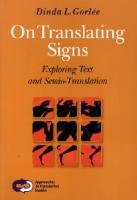Translating Cultures: Perspectives on Translation and Anthropology 9781474215879
The task of the anthropologist is to take ideas, concepts and beliefs from one culture and translate them into first ano
247 37 13MB
English Pages [292] Year 2003
Recommend Papers

- Author / Uploaded
- Paula G. Rubel
- Abraham Rosman (editors)
File loading please wait...
Citation preview
Introduction: Translation and Anthropology Paula Rubel and Abraham Rosman
The central aim of the anthropological enterprise has always been to understand and comprehend a culture or cultures other than one's own. This inevitably involves either the translation of words, ideas and meanings from one culture to another, or the translation to a set of analytical concepts. Translation is central to "writing about culture". However, curiously, the role that translation has played in anthropology has not been systematically addressed by practitioners, even though translation has been so central to data-gathering procedures, and to the search for meanings and understandings, which is the goal of anthropology. One of the reasons for this has been the ongoing internal dialogue about the nature of the discipline. There are those who feel that anthropology is a social science, with the emphasis on science, whose methodology, which usually involves analytical concepts, sampling and quantification, must be spelled out in detail. On the other side are those who emphasize the humanistic face of the field, and who feel that the way to do fieldwork cannot be taught. Still others, who focus on achieving understanding of another culture, think it can only be achieved by "total immersion" and empathy. Since its inception as a discipline and even in the "prehistory" of anthropology, translation has played a singularly important role. In its broadest sense, translation means cross-cultural understanding. The European explorers and travelers to Asia and later the New World were always being confronted with the problem of understanding the people whom they were encountering. Gesture and sign language, used in the first instance, were soon replaced by lingua francas and pidgins, and individuals who learned these lingua francas and pidgins became the translators and interpreters. These pioneers in cross-
![Translating Cultures: Perspectives on Translation and Anthropology [First Edition]
9781859737408, 9781859737408](https://ebin.pub/img/200x200/translating-cultures-perspectives-on-translation-and-anthropology-first-edition-9781859737408-9781859737408.jpg)

![Languages – Cultures – Worldviews: Focus on Translation (Palgrave Studies in Translating and Interpreting) [1st ed. 2019]
9783030285098, 9783030285081, 303028509X](https://ebin.pub/img/200x200/languages-cultures-worldviews-focus-on-translation-palgrave-studies-in-translating-and-interpreting-1st-ed-2019-9783030285098-9783030285081-303028509x.jpg)





